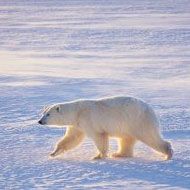
Total number of ice-covered days in decline
Sea ice is melting across all 19 polar bear populations in the Arctic, new research has found, threatening the feeding and breeding capabilities of the bears.
Research published in Cryosphere, a journal of the European Geoscience Union, is the first to quantify the sea ice changes in each polar bear subpopulation across the entire Arctic region.
It found the critical timing of the sea ice break-up and sea ice freeze-up is changing across all areas in a way that is harmful to polar bears.
Polar bears primarily eat seals, which provide the necessary fats and nutrients needed to cope with the harsh Arctic environment. As the bears cannot outswim their prey, they perch on ice as a platform and ambush seals at breathing holes.
The new study draws upon 25 years of satellite data showing daily sea-ice concentration in the Arctic.
Across all 19 polar bear populations, the researchers found that the total number of ice-covered days fell at a rate of seven to 19 days per decade between 1979 and 2014. Sea ice concentration during the summer months - when some subpopulations are forced to feed on land - also declined in all regions, by one per cent to nine per cent per decade.
Furthermore, the researchers found a consistent trend across all polar bear regions for an earlier spring ice melt and a later autumn freeze-up. Arctic sea ice retreats in the springtime as daylight reappears and temperatures warm. In the autumn months, the ice sheets build up again as temperatures drop.
“These spring and fall transitions bound the period when there is good ice habitat available for bears to feed,” said Kristin Laidre, a researcher at the Polar Science Center. “Those periods are also tied to the breeding season when bears find mates, and when females come out of their maternity dens with very small cubs and haven’t eaten for months."
The researchers also observed that spring melting was three to nine days earlier per decade, and autumn freeze-up was three to nine days later per decade.
“We expect that if the trends continue, compared with today, polar bears will experience another six to seven weeks of ice-free periods by mid-century,” said Harry Stern, a researcher at the University of Washington’s Polar Science Center. "The trend appears to be linear and isn’t accelerating or levelling off."



 The BSAVA has opened submissions for the BSAVA Clinical Research Abstracts 2026.
The BSAVA has opened submissions for the BSAVA Clinical Research Abstracts 2026.